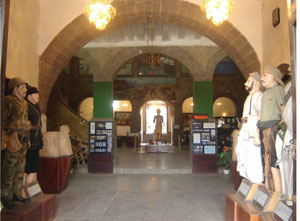
The Yemeni Military Museum: A journey through Yemen’s historical eras [Archives:2007/1040/Last Page]
April 9 2007
 |
 |
[email protected]
Yemeni civilization is rooted deeply in history and considered one of the greatest civilizations that ever existed among both Arab and the world's countries. Yemen's museums are some of the proof of the richness of Yemeni civilizations.
The three main Yemeni museums are: The National Museum, The Public Heritage Museum and The Military Museum, each with a branch in governorates such as Aden, Taiz, Ibb, etc. The Military Museum includes the richness and civilization of Yemen's armed forces and their role in civilizations throughout Yemeni history.
At the museum's door, soldiers stand gently and patiently to welcome every visitor. But in fact, they aren't real soldiers, only statues depicting Yemeni soldiers down through the ages.
The first attraction for visitors are the cars on the first floor, which is called the museum's “internal square.” Actually, it's a unique display revealing each car's specific history related to a specific age.
Visitors to the Military Museum must follow its plan and commence their journey on the right side, where the ancient age begins. The museum is laid out gradually, beginning with the era before history and the modern Stone Age in 6,000 B.C.
The Military Museum building itself is a historical place. As mentioned on a sign above the museum door, it initially was built as a school for industrial workers during the Ottoman occupation era at the end of the 19th century in Hijra year 1317, which corresponds to 1902.
It then became an industrial prison for Imam Ahmed Hamedudeen's opponents in 1920 before being converted into a guesthouse for the Iraqi military mission in 1940. It was still a guesthouse at the eruption of the 1962 revolution and then was used for the Ministry of Interior and Security before finally becoming the Military Museum in 1984.
Sometimes called the National-Military Museum, it also includes Yemeni achievements in education, exploration and culture, which are reflected in the vault of past Yemeni civilizations.
The museum is divided into 11 halls, with each hall representing a specific era in Yemeni history. They are ordered historically, beginning from the age before history and the Stone Age until the events of Yemeni unity.
The visitors of the military museum are both Yemeni and foreigner's tourists. Every day the museum administration receives Yemeni people from different governorates visiting the museum. “We have a plan for schools and some official delegations who like to make visits to the museum and discover the heritage of Yemeni civilizations in general and the great history of Yemeni army.\” Mohammed Haza'


